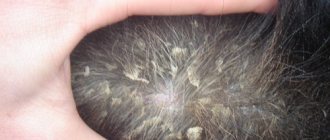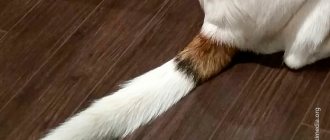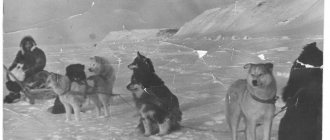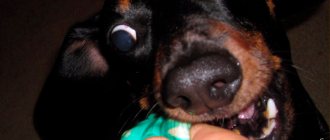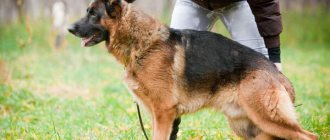The German Shepherd breed has long won the hearts of mankind.
They have all the qualities that a true friend needs.
Moreover, not a single patrolman or policeman can do without these dogs.
They are not only loyal friends, but also brave defenders who will do everything to save their owner.
So how do you choose a puppy?
Let's find out in detail from the article.
At what age are weaned from the mother?
Weaning too early can have a negative impact on the puppies' psyche . This moment must be timely, it must be chosen correctly.
Weaning should occur before the first vaccination . It is done at 2 months.
At 3-4 weeks, complementary foods are already introduced for puppies, which means that weaning from the mother should occur gradually by 5-6 weeks.
In order not to suddenly deprive the puppies of their mother's milk, it is allowed to let the puppies suckle at night. Over time, this too will have to be eliminated.
What types of German Shepherds are there?
German There are several classifications to divide German Shepherds: by coat length, by color and by breeding line.
Types of German Shepherds by coat length:
- Short-haired. The coat of such shepherds is thick, short and close to the body. They have a good undercoat. The fur on the neck, tail and hips is longer than on the rest of the body;
- Long-haired. These dogs have soft, slightly wavy fur with an undercoat. The dog has a parting on its back. The especially thick coat on the neck and behind the ears, behind the ears and on the back of the paws forms feathering.
Crossing long-haired and short-haired shepherd dogs is prohibited . These are two different breeds, breeding records are kept separately.
Types of German Shepherds by color:
- Black. The rarest color for German Shepherds, only 5% have it. Black dogs of this breed are the real elite;
- Black and tan. The body is black, and the stomach and paws on the inside are light.
- Zonal. Each hair is colored in ring zones: light, then black, yellow, black.
- Black-and-white. The fur on the back is black, the belly, neck and limbs have tan markings of various colors: chocolate, reddish, yellow, fawn, gray. The muzzle is black or gray;
- White. A German Shepherd can be white if both parents have the recessive gene responsible for this color. In Canada, they even managed to develop a separate breed of such dogs.
The red color of the German Shepherd does not meet the standard, but this does not prevent it from becoming your pet and friend. This also applies to the gray color.
Types of dogs by breeding line:
- West Germany . It is a high breeding line. These dogs are best suited to the show standard. The dog's appearance was detrimental to its overall qualities. Such dogs are not suitable for official duties;
- Western operating lines - Czech/Slovak, East German , Dutch, Belgian . These dogs, on the contrary, have everything to become excellent service pets. They differ from their West German relatives;
- American line . The Americans focused on the appearance and ease of movement of the dog, because of this, their build is slightly different from their other brothers. American line dogs are balanced, calm and easy to train;
- English line . Their ancestors are sheepdogs brought to England in the mid-20th century. Over time, they were practically driven out of the island by their continental relatives.
How to choose the right German Shepherd puppy: definition of the breed, differences from a mongrel
You can learn how to choose a German Shepherd puppy and what points you need to pay attention to by reading this article.
Choosing a good German breed puppy is quite a difficult task. This is due to the fact that recently the German shepherd breed has gained considerable popularity and, accordingly, demand.
In this regard, some breeders sacrifice the quality of the breed in pursuit of the number of individuals.
You shouldn’t limit yourself to inspecting just the first puppy you like.
If you still decide to choose a dog of this breed, then it is highly recommended to look at several options, since the first impression can be deceiving, and even champion puppies do not always look like their parents.
It can be difficult to guess the future character and abilities of a puppy, because the fact that the parents were champions does not exclude the need to raise a future champion.
All German Shepherd puppies are cute and funny, but it is recommended that you look through several options to choose your pet.
At the same time, it is necessary to keep in mind that in order to win, the puppy also needs proper nutrition, and the owner needs knowledge of the characteristics and training skills. If a puppy is purchased to participate in various exhibitions, then you need to know that such a dog’s career may not last long, about 5-6 years.
Dog examination
How to choose a German Shepherd puppy? First of all, you should ask how many puppies were in the litter.
This is important, since in order to be fully fed, puppies should be no more than 10 years old - otherwise they will not get enough of their mother’s breast milk and will not have good health and good endurance. A female breeding individual should give birth no more than once a year.
If this happens more often, the dog’s body is severely depleted and the offspring are born weak. However, the thin and tired appearance of the bitch does not mean anything, since this is normal in her position. Shedding is also allowed; this is a common occurrence after childbirth.
Afterwards, you can choose a specific small pet. If the owner allows, it is better to pick up the puppy and carefully examine him. It doesn’t hurt to take an interest in the dog’s stool - if it is mostly liquid, then there are diseases of the gastrointestinal tract.
You need to choose a shepherd dog based on its external characteristics; you can use them to distinguish the breed. Typically they must meet the following parameters:
- the coat should not be long;
- there are no combs around the ears and in the neck area;
- there should be no discharge in the corners of the eyes;
- the ears should be clean and free of any odor - if it is present, it means that there is an inflammatory process of a purulent nature in them;
- the puppy must be of average fatness;
- mucous membranes should be clean and have a pink tint;
- The eyes should be clear and the eyelids should be tight-fitting.
Puppies should not be emaciated or, on the contrary, round like balls - average fatness is welcome
What should a shepherd be like?
- The puppy's skeleton should be strong and strong.
- The forelimbs are usually straight; their bending or curvature may indicate a disease such as rickets. This also applies to the puppy's hind legs. Large joints on the legs indicate good and strong bones of the puppy. When he grows up, they will look proportional to the rest of his body.
- Your puppy's feet may be plump, with thick pads and dark nails. In general, the size of the paws should be compact. The presence of extra toes on the hind legs is not allowed. Usually purebred puppies have lumpy, strong paws.
- The eye color of puppies has a blue tint, but this disappears 40 days after birth. You should not opt for those representatives of this breed who have light-colored eyes, much less different eye colors.
- The muzzle of a real shepherd is not sharp, and the forehead is not wide. There should be a pronounced gap between the forehead and muzzle.
- The erect tips of the ears indicate their early ossification, which indicates an imbalance in the calcium content. They shouldn't be like this, especially before 3.5 months.
As for body features, the slope and length of the croup are important.
The thigh size must correspond to a certain length. A good puppy has a developed wide shoulder girdle, a short back and lower back, but at the same time the hips are quite wide. The tail has its own characteristics - it should not have kinks. Now regarding the color. You can identify a German Shepherd puppy by its coat color; it should be black and tan.
It’s better when there’s more of a fall, this only speaks in favor of the dog. Usually black individuals also have puppies with a similar color.
The ears of a purebred healthy puppy are lying down, the color is black with tan, the eyes are blue.
Crossbreeds and mongrels - how do they differ from the real breed?
How to identify a German Shepherd puppy without confusing it with any crossbreed or even a mongrel. Closer to two months, real German Shepherds change greatly in appearance. If earlier they looked clumsy, then from this age their appearance takes on a very harmonious outline. This is an important sign by which the breed is determined. Mutts don't usually grow that fast.
How to correctly identify a German Shepherd puppy can be determined by the following signs:
- A narrow, convex forehead. Mutts have a distinct furrow on their forehead.
- The nose is always black and large.
- Characteristic scissor bite.
- No dental defects.
- Purebred individuals may have burdock-shaped ears; as they grow, they will become normal. Mutts' ears remain floppy forever.
- A purebred dog is distinguished by a massive and developed chest. In mongrels, it resembles the shape of a barrel.
- Paw shape. Purebred shepherd dogs have thick, strong, large and even paws of an elongated shape.
- The purebred individual has a drooping tail, shaped like a saber blade. In mongrels it curls.
- Wool. In a purebred dog it is hard, but in an ordinary yard dog it is softer and silkier.
The shepherd's tail is straight, it resembles a saber blade and has no creases or bends.
Watching the following video will help you correctly identify a German Shepherd. In addition to external signs, you need to pay attention to the dog’s habits, which will also give away the breed. Thus, a purebred pet is easy to train, quickly remembering and willingly following the owner’s commands. Mongrels are difficult to cope with this process.
How to distinguish from a mongrel?
Anyone can distinguish a purebred shepherd at 5 or 6 months from a mongrel, but not every buyer can do this at 1 or 2 months.
The main rules that will allow you to avoid being deceived:
- When purchasing, ask where the puppy’s parents are and ask to show them. Also find out what documents the parents have. To be 100% sure, you can call the Club and find out if these dogs are registered there;
- Puppies must be branded. The data on the stamp and in the metric must match;
- The puppy's eyes have an almond-shaped cut; when they turn their head, the white white is visible. Because of this, the eyes of the “German” are often compared to human ones;
- The iris can be from dark yellow to dark brown. The eyes may be blue for up to two months. Mutts have protruding, white, yellowish or speckled eyes.
- By the beginning of the shift, the shepherd dog should have 28 teeth. It is unacceptable for them to grow together or have an incorrect bite;
- The head of a purebred puppy should be proportional to the body. The forehead should not hang over the muzzle. There should be no beard between the eyebrows. The nose is black without a point. Lips in the color of your nose;
- Neck of medium length;
- The back is short and strong, the chest does not fall below the elbows;
- The tail should be long, it never rolls into a ring, and is always straight;
- The paws are large and large;
- The usual color of the German Shepherd is saddleback, but others are allowed. There may be a white martin on the chest, but spots inside it are not allowed;
- A purebred puppy will not be afraid of a person, but will try to follow any of his instructions - this is on a subconscious level. Mongrels avoid people. Also subconsciously.
How to distinguish a German Shepherd puppy from a crossbreed?
The concepts of “mongrel” and “mongrel” are often confused. Both mestizos and mongrels are not purebred, but if the former are obtained by crossing, then the latter are said to be “without clan or tribe.”
So, to identify a purebred German Shepherd, you need to know a few things:
- Usually purebreds are sold with documents
, pedigree and brand. They are not afraid to show the parents, the address of the nursery (or club) is known, that is, there is an opportunity to see the animal. - There is a certain
breed standard. About the structural features, tail and features have already been said, we can add that: The nose is large and black in color; - Concentrated gaze;
- Paws are smooth, large;
- There are no black spots on the chest;
- The richer the eye color, the more likely it is that the puppy is purebred;
- The taste is scissor-like.
Metis – what is it? The result of crossing two different breeds, therefore, the puppy can show signs of other breeds that are not typical for German shepherds.
How to distinguish a German Shepherd from a mongrel There are few people who have not ever dreamed of becoming the proud owner of a German Shepherd - a dog that occupies an honorable third place on the scale of dog intelligence. But oddly enough, most mongrels are similar to this breed. How to distinguish these two dogs from each other, especially since it is extremely difficult to do so before two months of age? Definition of a German Shepherd and a mongrel The German Shepherd is a dog bred at the end of the 19th century in Germany as a service dog based on the Central and South German varieties of guard breeds, a descendant of the northern wolf. According to the FCI classification, it belongs to Group 1 – herding and cattle breeding. A self-confident, well-managed, good-natured dog with strong nerves. A mongrel is a dog that has not belonged to any breed for several generations, often homeless. Due to strict natural selection, it has good health. First of all, it should be said that you need to study the breed standard very well before buying a dog. It is very difficult for a non-professional to distinguish a German Shepherd from a mongrel. But at least some conclusions can be drawn. Distinctive features A shepherd puppy grows very quickly, as they say, by the day. His body develops quite harmoniously, with the possible exception of adolescence, when puppies have a somewhat awkward appearance. The mongrel does not gain weight as rapidly and does not grow as quickly. Training. Already from 2 months of age, a German Shepherd puppy can begin to be trained. He quickly, after several repetitions, remembers commands and carries them out with pleasure. The mongrel cannot do this. A head that is coarse or too light is an indicator of outbredness. In a shepherd it is moderate in all respects. The forehead is slightly convex. The transition from it to the muzzle is weakly expressed. The nose is quite large and always black. In mongrels, unlike shepherd dogs, the frontal groove is clearly visible. Moles. Five black moles near the corners of the mouth are clearly visible on a shepherd puppy, but they are not an indicator of the breed. The eyes are almond-shaped, clear and dark, smoky blue until two months of age, the look of the shepherd is focused and intelligent. The same cannot be said about the mongrel. Her eyes are more rounded and often bulging. The ears of the German Shepherd, especially those of puppies, are very long, “burlap” until they begin to stand up. In a mongrel, if it is not a mixed breed, they are of medium size and can remain hanging. The shepherd's chest is well developed and massive. In mongrels it is more barrel-shaped. Paws. Experienced breeders determine the breed, first of all, by the structure of the paws. In purebred dogs, they are “aristocratic” – moderately elongated, straight and large. In German Shepherd puppies they stand out especially. When standing, the German Shepherd's tail is lowered and resembles a saber. The mongrel has it thrown into a ring above his back. Color. The shepherd is characterized by a black coat color. White spots on the chest, which are quite common in mongrels, are unacceptable for the breed. The coat of the German Shepherd is somewhat harsh, although very pleasant to the touch. The mongrel's coat is softer, as if silkier. The skin of a German Shepherd is very elastic, it does not form saggy or folds. Movement. A purebred dog carries its paws very close to the ground, without throwing them, unlike a mongrel dog. The back is straight both when standing and when walking. Moves at a low, creeping trot. TheDifference.ru has determined that the difference between a German shepherd and a mongrel is as follows: The structure of the paws, chest and head of a German shepherd is very harmonious, moderately massive, without unnecessary bends and bulges. The movements of a purebred dog are special - like an aristocratic dog. A purebred puppy grows faster than a purebred puppy and begins to remember commands faster. The shepherd's look is peculiar - too concentrated, smart and kind at the same time. The mongrel's eyes are almond-shaped and round. Without documents and a brand, it is extremely difficult to distinguish a German shepherd from a mongrel.
The German Shepherd is known as an excellent watchman and guard. In this connection, many people have a desire to have this dog in the house. Future owners need to know how much a German shepherd costs and how to choose the right pet so as not to make a mistake.
What is the best age to buy?
Experts recommend taking puppies that have already been vaccinated, branded and weaned from their mother.
This is 3-4 months old . Some also take older Germans.
But you need to remember, the sooner you start raising a puppy, the greater your chances of success.
From the breeder you will receive the first recommendations on how to keep and feed your pet..
Where is the best place to buy - private owners, breeders, nurseries?
Your choice of location depends on the goals you are pursuing when purchasing a dog.
If you are interested in the exhibition and competition career of an animal, then you need a show-class pet that meets all standards and has all the documents on the breeding pedigree . In this case, you will have to fork out money and buy a dog in a kennel or from a breeder.
Breed-class dogs are most suitable for breeding, not exhibitions. You can also purchase such a puppy from the breeder.
If you just need a dog to spend time together, protect the territory, or for the soul, then a pet class is also suitable.
This type of shepherd dog can be bought from any private individual.
Expert opinion
Kozhevin Semyon Kirillovich
Expert dog handler.
“The right thing to do is to choose a place first. Before doing this, don’t be lazy, read reviews about the nursery or breeder. If you plan to take a puppy “from your hands”, be extremely careful, you risk choosing a “pig in a poke”. Look at what real German Shepherd puppies look like, at least on the Internet, get acquainted with their distinctive features, and then compare them with the dogs you choose from. If you have enough information in your head, you will never be deceived. Be persistent, ask, be interested. Often, even by the breeder’s reaction to questions, you can understand whether he is conscientious or not.”
Rules for choosing a German Shepherd puppy: at what age is it better to purchase and how to distinguish it from a mongrel
The German Shepherd breed has long won the hearts of mankind.
They have all the qualities that a true friend needs.
Moreover, not a single patrolman or policeman can do without these dogs.
They are not only loyal friends, but also brave defenders who will do everything to save their owner.
So how do you choose a puppy?
Let's find out in detail from the article.
Where is the best place to buy - private owners, breeders, nurseries?
Your choice of location depends on the goals you are pursuing when purchasing a dog.
If you are interested in the exhibition and competition career of an animal, then you need a show-class pet that meets all standards and has all the documents on the breeding pedigree . In this case, you will have to fork out money and buy a dog in a kennel or from a breeder.
Breed-class dogs are most suitable for breeding, not exhibitions. You can also purchase such a puppy from the breeder.
If you just need a dog to spend time together, protect the territory, or for the soul, then a pet class is also suitable.
This type of shepherd dog can be bought from any private individual.
“The right thing to do is to choose a place first. Before doing this, don’t be lazy, read reviews about the nursery or breeder. If you plan to take a puppy “from your hands”, be extremely careful, you risk choosing a “pig in a poke”.
Look at what real German Shepherd puppies look like, at least on the Internet, get acquainted with their distinctive features, and then compare them with the dogs you choose from. If you have enough information in your head, you will never be deceived. Be persistent, ask, be interested.
Often, even by the breeder’s reaction to questions, you can understand whether he is conscientious or not.”
Main rules - what to look for when buying
- Find out how many puppies were in the litter. If more than 10, then most likely the bitch had problems during childbirth and feeding;
- Look at the conditions in which the mother and puppies are kept, what they eat and where they sleep;
- Pay attention to the puppy’s appearance, its fatness and physical perfection;
- The puppy should not smell unpleasant, the mucous membranes should be clean;
- The forehead should not be too wide and the muzzle should not be pointed. Dogs have a scissor bite;
- The puppy should not fall while running; on the contrary, coordination should be good and there should be no lameness;
- The puppy's build should be proportional;
- Babies have coats without receding patches, most often saddle-colored.
The puppy's limbs should not be twisted, the tail of the German Shepherd should not be bent or crooked..
What does a healthy puppy look like?
A healthy German Shepherd puppy looks like a little bear.
The back of puppies is smooth, dense and without any deflections.
The baby should have a wide pectoral girdle, their chest is deep . There should be no fifth toes on the hind legs - this is a defect. Also, the paws should not have any bumps. The tail is long and straight.
There should be no stiff ends on the ears - this indicates an excess of calcium, such ears may not stand up in the future. Blue eye color is allowed in the first months, then it begins to darken. At the same time, there should be no discharge from the dog’s eyes and ears.
Healthy puppies have no damage to their skin . It is elastic and soft.
Assessment of mental and other abilities
To determine the intellectual abilities of a German shepherd, a special test by zoologist William Campbell has long been used.
It helps determine:
- The puppy's desire to communicate;
- Its ability to follow its owner;
- Puppy obedience level;
- The desire for dominance;
- Self-esteem.
But such a test can be carried out by a breeder or specialist, but you can only assess the general capabilities of the puppy.
Look at the parents and determine if they have cowardice, aggression or hysteria - this can be passed on to the puppy. The baby should be a curious little explorer.
If timidity in a puppy is also explained by the fact that it can suffer aggression from other brothers, but cowardice is not allowed in this breed.
The puppy should not be afraid of you, noise, not at all, he will be interested in sniffing and getting to know a new person.
The puppy must be socialized and communicate well with its other brothers and mother.
This will make your parenting task easier.
In general, the baby German Shepherd is lively and inquisitive, he is interested in exploring the world, showing interest in new things.
Compatibility test
The puppy should suit your temperament and character. Therefore, play with him, observe how he behaves around his brothers. Also, it would not be amiss to conduct several tests with him in order to understand what character traits the puppy already has.
Based on the puppy’s reaction, draw conclusions about what he will become and whether you need a pet with such a character.
Who to choose - a boy or a girl?
Boys always have better conformation and are more successful in exhibitions. This is also due to the fact that females are subject to estrus twice a year, which means pregnancy and childbirth.
The latter factors are also worth keeping in mind when choosing a dog.
Do not forget that the male will also need the bitch, but all the consequences fall on her.
If you plan to make a show career, choose a male; a female is more suitable for breeding.
Otherwise, only the owner can choose which gender of pet he prefers.
Conclusion and conclusions
Choosing a puppy is not an easy task. After all, you are taking a dog not for a year or two, but for a long time.
Therefore, it is important to understand the breed standard and be attentive to the puppy’s behavior and build . Literacy in this matter will help you choose a real “German” - healthy, loyal and brave.
From the video you will learn how to choose a German Shepherd puppy:
Main rules - what to look for when buying
- Find out how many puppies were in the litter. If more than 10, then most likely the bitch had problems during childbirth and feeding;
- Look at the conditions in which the mother and puppies are kept, what they eat and where they sleep;
- Pay attention to the puppy’s appearance, its fatness and physical perfection;
- The puppy should not smell unpleasant, the mucous membranes should be clean;
- The forehead should not be too wide and the muzzle should not be pointed. Dogs have a scissor bite;
- The puppy should not fall while running; on the contrary, coordination should be good and there should be no lameness;
- The puppy's build should be proportional;
- Babies have coats without receding patches, most often saddle-colored.
The puppy's limbs should not be twisted, the tail of the German Shepherd should not be bent or crooked..
Tips for choosing German Shepherd puppies: the main differences from mongrels
One of the main questions when choosing a dog breed is how to identify a German Shepherd puppy from a mongrel and avoid making mistakes when buying a dog. After all, many unscrupulous sellers offer exact copies of the desired breed under the guise of a purebred German.
What should a shepherd be like?
The German Shepherd is a breed of dog that was developed back in the 19th century in Germany. The main purpose of the animal is to serve man and protect him. A pet of this breed must be well-managed, good-natured and have a stable psyche.
Characteristics of the breed
Even experienced dog breeders, in order to make the right choice of such a pet, sometimes have to carefully study it before purchasing, especially if the puppy is not yet 60 days old. This is why it is not recommended to purchase puppies under 1 month of age.
Important! Newborn shepherd puppies do not yet have noble characteristics, so it is not impossible to recognize their growth and correct development.
You should study as much material as possible on this topic, and also consult with experts on how to choose a German Shepherd puppy and identify false signs in the dog’s appearance and behavior.
How to distinguish a German Shepherd puppy from a crossbreed
To distinguish a purebred dog from a crossbreed, you first need to know about some things. As a rule, when selling purebred dogs, the dog breeder provides a full set of pedigree documents. An honest seller will show the parents without any problems and will not hide the address of the nursery.
Training a German Shepherd at home
During an external examination, it is necessary to compare the characteristics of the dog with the breed standards. You need to look very carefully, because sometimes there are very similar, almost indistinguishable crosses. It is also worth paying attention to the dog’s gaze - it should be focused and confident. In addition, the purebred German has smooth, large paws.
Important! Uncharacteristic features in appearance or signs of a mixture with other breeds will help identify the dog’s mixed blood.
German Shepherd mixes
Main features: head
If the dog's head is disproportioned relative to the body, then most likely it is not a purebred German. In purebred dogs, the forehead is of medium width, convex in shape and does not hang over the muzzle.
The black nose lobe does not have any points. Slight hump nose is allowed. The inside of the lips may be spotty - this is not bad, but undesirable. The bump on the back of the skull should be easily palpable.
Back, chest
The back of the Germans is quite strong and not very long. There are no fractures in the lumbar region. The sternum is wide; in young individuals it should not sag below the level of the elbow joint.
Examination of parents and their puppies
If the breeder has nothing to hide, then he will allow you to visit the puppy’s parents without any problems. It is necessary to observe the father and mother, for example, during a walk, compare external and behavioral characteristics with the standard.
Examination of the puppy's parents
Topline of a German Shepherd
The topline is the visual line that runs from the base of the neck to the base of the tail. In purebred dogs, it has smooth outlines, without any clearly segmented areas.
Tail
Shepherds have a fairly long tail. The tail part ideally continues the spinal column. When excited, it should not rise above the level of the main line, and when the tail is tucked, no pit should form.
Paws
Thick-footed puppies have middle paws that are parallel and pressed to the sternum at the elbow. The heels, like the claws, are painted dark. The fingers close into a ball.
Important! You should not buy dogs with vestigial or removed toes.
Weight
When choosing a representative of the German breed, you should compare the weight parameters of the animal with the table.
German Shepherd puppy weight
Ears
Young shepherd dogs' ears stand up only at six months of age. Often they first look like a “house”, then they fall, and only later they begin to rise one by one until they are completely strengthened.
Teeth
The optimal number of teeth is 28. The bite should have a scissor-like appearance. The incisors on both jaws should be opposite each other. In shepherd dogs, the lower canines slightly overlap the upper ones.
Frame
If the height of the dog’s body at the withers is commensurate with the length of the body (quadratic shape), and its height exceeds 60 cm, then most likely a mestizo is being sold under the guise of a purebred shepherd dog. The main sign of noble blood is a smooth topline.
Campbell's test
As an additional check, you can take Campbell tests. The test can be carried out as early as 7 weeks of age; it is better to do this in the presence of specialists who can correctly interpret all the indicators. Testing to determine behavioral characteristics allows potential owners to make sure that the purchase is correct.
Verification of documents
The best proof of a puppy's thoroughbred are documents for the parents and for the baby himself - a certificate of origin of the dog, with date of birth, color and name. The documents will be confirmed by a stamp on the inside of the puppy's hind paw.
When choosing a German Shepherd puppy, it is advisable to undergo a comprehensive check, taking into account all the nuances of the breed. This will allow you to protect yourself from all sorts of fraudulent tricks of the breeder and adopt a worthy representative of your kind.
What does a healthy puppy look like?
A healthy German Shepherd puppy looks like a little bear.
NOTE!
The paws should be wide and compact; when looking at the dog from the front, its front paws and chest should form the letter A.
The back of puppies is smooth, dense and without any deflections.
The baby should have a wide pectoral girdle, their chest is deep . There should be no fifth toes on the hind legs - this is a defect. Also, the paws should not have any bumps. The tail is long and straight.
There should be no stiff ends on the ears - this indicates an excess of calcium, such ears may not stand up in the future. Blue eye color is allowed in the first months, then it begins to darken. At the same time, there should be no discharge from the dog’s eyes and ears.
Healthy puppies have no damage to their skin . It is elastic and soft.
Determining a purebred “German” puppy
To build a successful show career, you need a purebred puppy with exceptional exterior features. Only then can one hope for the highest marks from the judges and profit from his further participation in the selection.
Important! If a dog breeder is just starting his career and does not have sufficient knowledge about the breed and its standards, it is better to invite a specialist to select a puppy. An experienced dog handler will immediately determine the best baby of the litter and help you make a choice.
By exterior
All German Shepherd puppies are different from each other. This depends on many factors, including the number of babies in the litter, the nature of their diet and where they are kept. During the examination, you need to objectively evaluate all the puppies and choose the one you like. They are already beginning to examine it for external defects.
When choosing a puppy, you should pay attention to the following details:
- the hair of a small pet should not be too long;
- the backbone must be strong and powerful;
- the joints should be large enough, not proportional to the whole body; with age they will become more harmonious;
- the paws should be straight, without curvature, the claws should be even, the pads should be strong and not flabby;
- up to 2 months of age, a shepherd’s eyes can remain blue, but experts say that by a month they are already beginning to darken a little, there is no mucus or foreign secretions;
- ears should be soft, if they become before three months of age - this is an excess of calcium in the body;
- the tail should be without kinks;
- powerful hips and body, shortened loin - these are signs of a good puppy.
A thorough examination and objective assessment of the pet’s external characteristics will help you choose the best representative of the litter.
By parents
When buying a puppy, you should examine not only the kids, but also its parents. It is important that they not only meet the standard format, but also have a good psyche, are balanced and calm.
You should also check the place where the puppy was kept with a nursing mother. It should be clean, free of unpleasant smells, warm and cozy. The mother should not be exhausted or sick.
Don't forget about documents
The puppy's pedigree is an important document that needs to be carefully checked before purchasing. This will avoid various genetic diseases, hereditary pathologies and other problems. It is necessary to study several generations of dogs in this family to make sure that the puppy is truly a worthy representative of the breed and is purebred.
Assessment of mental and other abilities
To determine the intellectual abilities of a German shepherd, a special test by zoologist William Campbell has long been used.
It helps determine:
- The puppy's desire to communicate;
- Its ability to follow its owner;
- Puppy obedience level;
- The desire for dominance;
- Self-esteem.
But such a test can be carried out by a breeder or specialist, but you can only assess the general capabilities of the puppy.
Look at the parents and determine if they have cowardice, aggression or hysteria - this can be passed on to the puppy. The baby should be a curious little explorer.
If timidity in a puppy is also explained by the fact that it can suffer aggression from other brothers, but cowardice is not allowed in this breed.
The puppy should not be afraid of you, noise, not at all, he will be interested in sniffing and getting to know a new person.
The puppy must be socialized and communicate well with its other brothers and mother.
This will make your parenting task easier.
In general, the baby German Shepherd is lively and inquisitive, he is interested in exploring the world, showing interest in new things.
Compatibility test
The puppy should suit your temperament and character. Therefore, play with him, observe how he behaves around his brothers. Also, it would not be amiss to conduct several tests with him in order to understand what character traits the puppy already has.
IMPORTANT!
See if he runs up to you as soon as you leave him, if he follows your call, how much he is subject to submission and dominance - to do this, turn him over on his back and try to hold him in this position, stroke him and look at the reaction, take him hold him in your arms and observe his behavior - whether the puppy can remain at a distance from the ground in your hands.
Based on the puppy’s reaction, draw conclusions about what he will become and whether you need a pet with such a character.
Who to choose - a boy or a girl?
Boys always have better conformation and are more successful in exhibitions. This is also due to the fact that females are subject to estrus twice a year, which means pregnancy and childbirth.
The latter factors are also worth keeping in mind when choosing a dog.
Do not forget that the male will also need the bitch, but all the consequences fall on her.
If you plan to make a show career, choose a male; a female is more suitable for breeding.
Otherwise, only the owner can choose which gender of pet he prefers.


